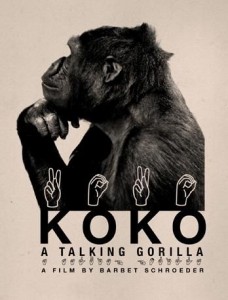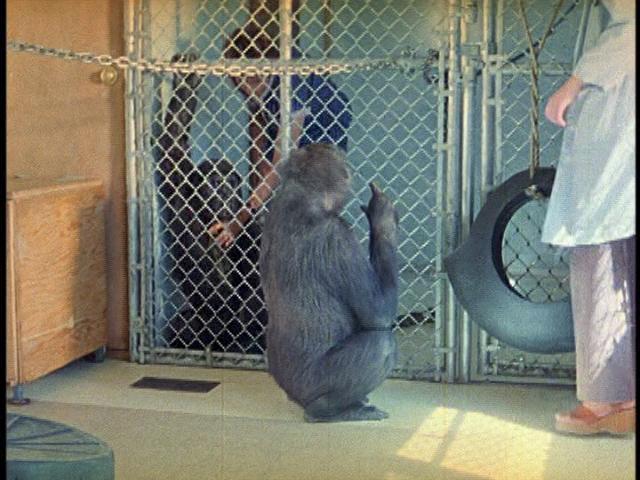Koko: A Talking Gorilla (1978)
“Who is to say that only human beings are persons? Isn’t this gorilla demonstrably a person?”
|
Synopsis: |
|
Genres, Themes, Actors, and Directors:
Review: But is this such a bad thing? After all, Penny and her associates had a noble goal in mind, one well in tune with the general sensibility of the 1970s — to move beyond human chauvanism, and be open to the possibility that homo sapiens aren’t the only “people” on Earth. Unfortunately, however, such notions were sorely misguided — as Pinker puts it, “Is it really ‘humility’ for us to save species from extinction because we think they are like us?” Ultimately, Penny’s project (which continues to this day) smacks of fanaticism; I’m all for protecting gorillas, but don’t think we need to teach them human language in order to justify this. Ultimately, then, I found watching Koko to be more disturbing than enjoyable — though I’m sure it made for fascinating viewing back in the time of its release, when the project was fresh and we were much more naive about its potential outcome. Children may also relate to watching Koko (whose equivalence in human intelligence, if one forces the issue, is roughly that of a toddler) reading a book with Penny, rejecting a yellow sweater in place of her favorite red one, and selecting her lunch items out of the refrigerator. For my part, however, the only scenes which I can look back on with genuine delight are those in which Koko interacts with her gorilla-friend Michael (see stills below); this is when she finally seems to be in her element, rather than forced to perform according to human expectations. Redeeming Qualities and Moments:
Must See? Categories
Links: |



One thought on “Koko: A Talking Gorilla (1978)”
First viewing (please note: coincidentally, exactly 10 years to the day of the assessment above). A once-must; or, rather, film fanatics *should* want to take this one in.
Personally, I sort of avoided it for a long time. When it (esp.) comes to documentaries, I can be known to postpone if I don’t feel all that drawn to subject matter, for whatever reason. But what I admire about certain docs in particular is their ability to – if not persuade – then encourage the viewer to seriously consider the possibilities looking for understanding inside material that he/she did not anticipate wanting to experience.
I felt that way here. This is a doc that becomes more interesting as it progresses, surprisingly so. As it reached its conclusion in the last 5 minutes, I could appreciate the impetus behind the research. As an impartial observer (admittedly, I cannot speak as any kind of authority in this line of study), I didn’t find anything that I witnessed “misguided”. Neither do I feel Koko was “forced” into doing much of anything – on the contrary, for the most part Koko seems genuinely engaged (most of the time) in the process of – not merely cultivation of language – but personal (as opposed to human) communication. She seems to…choose…to be involved.
I was esp. moved at the times when Koko was communicating what could be seen as subtle ‘throwaway responses’ to Penny. If I knew sign language myself, I might have picked up on more of those.
I didn’t find watching this “disturbing” for any reason – I felt more swept up in it as it went on. [I should qualify that: I was slightly disturbed by the remarks of the staff person from Koko’s zoo, from which she was removed. Since I had just spent over an hour watching Koko in action, it was odd listening to remarks stating that, essentially “gorillas are gorillas – they don’t understand ‘good’ or ‘bad’ or nothin’ – they’re gorillas”. I felt like I was listening to an ignorant truck driver.]
I esp. liked the film’s summation – the idea of everything being connected in nature; that, somehow, nothing is really separate and of itself.